Excerpts from Jim Conrad's
Naturalist Newsletter
Entry dated April 19, 2024, from notes taken about 1.5km northeast of Puerto de los Velazquez, Municipality of Pinal de Amoles; N21.134°, W99.667°, elevation ~2760 meters (~9050 feet); oak/pine forest on limestone bedrock; in the Eastern Sierra Madre Mountains of east-central Querétaro state, MÉXICO
AGERATINA PAZCUARENSIS
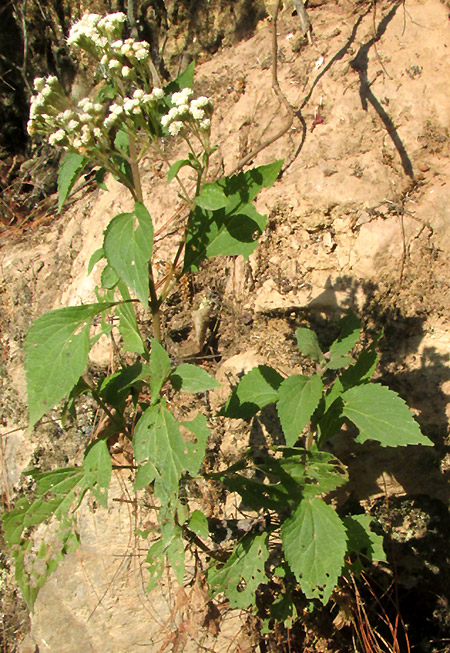
Rooted in a crack on the face of an old roadcut, the above member of the vast Composite/Aster/Sunflower Family caught my eye. That's because during the ongoing drought, few plants looked this healthy; our drought was the droughtiest drought recognized by the North American Drought Monitor, a D4 one.
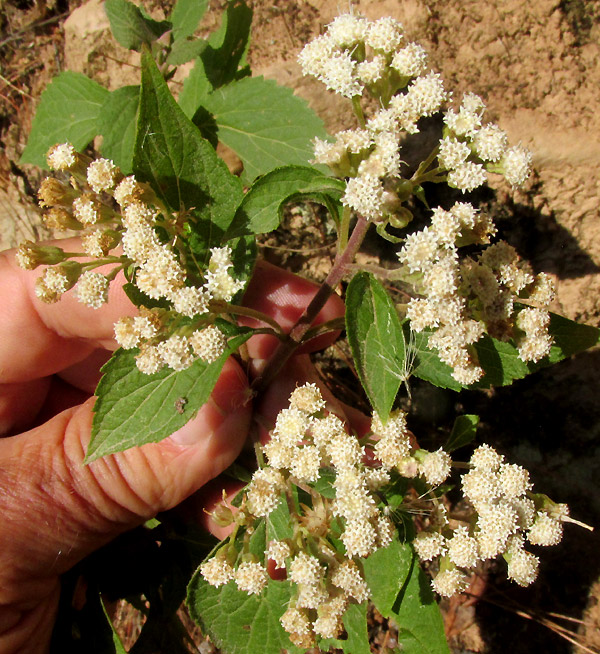
This plant's size, form, and particular kind of inflorescences composed of heads, or capitula, composed of numerous cylindrical disc florets, but with no petal-like ray florets radiating outwards from the capitula's margins, made clear that here was what in old days would have belonged to the big, commonly occurring genus Eupatorium. Eupatorium species often are called snakeroots, bonesets or thoroughworts.
The easy-to-recognize genus Eupatorium, which once held as many as 800 species, now has been fractured into who-knows-how-many genera, of which some are accepted by some experts and others not. Nowadays, less than about 60 species remain in the genus, among them North America's Eupatorium serotinum. All this shifting around has added to the difficulty of identifying plants looking like the above. Field marks to keep in mind seen in the above picture are that some of our plant's stems become dark purplish, and leaf petioles can be moderately long.

The above flowering heads, or capitula, display more good field marks. About 25 disc florets occur in each capitulum. Style branches extending from the corollas are slender all the way to their tips, and corolla lobes sometimes display a few short hairs.

From the side it's seen that inflorescence branches are short-hairy but not much so; they're puberulent. The branches are thicker, fleshier and more pliable than in many species, but not exceedingly so.
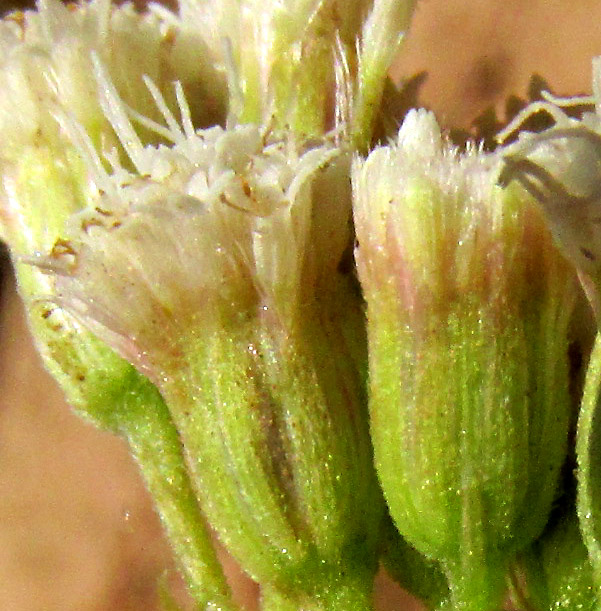
Finally some more determinative features are seen above. The green, urn-shaped involucres enclosing the disc florets' bottoms consists of scale-like phyllaries which are almost of the same length, and don't much overlap one another. Instead of arising strictly side-by-side, one series of phyllaries is a little inside the outside series; this is unlike most other species in the group. Moreover, each phyllary bears two distinct longitudinal veins. White, slender hairs -- the tops of pappuses atop the developing ovaries hidden inside the involucre -- substantially surpass the phyllary tips but not the open corollas. Phyllaries are weakly puberulent but not glandular. This combination of sometimes hard-to-see details is critical for identification.

The above opened capitulum shows black, puberulent, one-seeded, cypsela-type fruits with their disc floret corollas surrounded at their bases by pappuses composed of slender, white trichomes. The corollas are greenish in their lower halves, and the corolla tubes diminish in diameter toward their bases. No scale-like paleas separate the cypselae from one another.
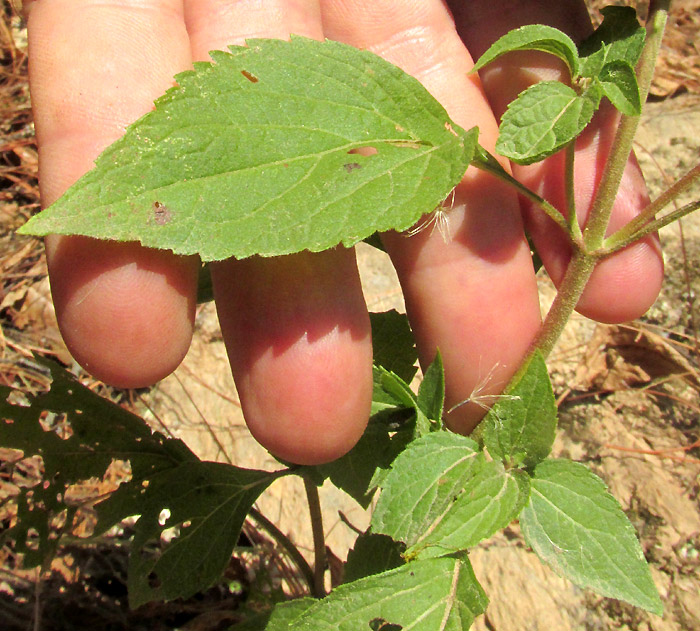
The puberulent leaves are oval, sharply tipped, and their margins are modestly toothed. Two conspicuous secondary veins arise near the blade's attachment with the petiole. Leaves arise in pairs opposite one another at stem nodes.
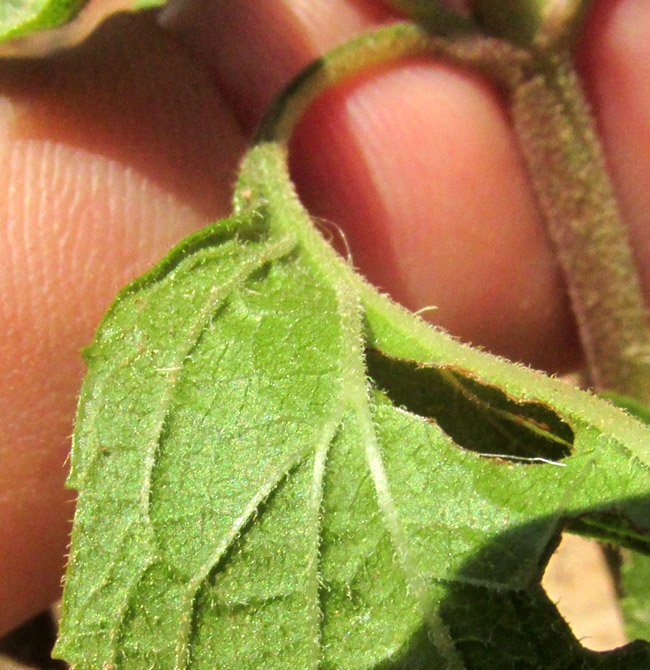
Below, leaves are puberulent along their veins. Note how the blade's base for a short distance descends the petiole.

Above, a vigorous, young stem is hairier than other parts of the plant, and some hairs are brownish.
All the above features -- especially the involucre's phyllaries being all the same height -- lead to the genus Ageratina, into which most New World Eupatorium species have been transferred. Currently Kew's Plants of the World database recognizes 315 Ageratina species. According to the 2016 study by José Luis Villaseñor and Enrique Ortiz entitled "La Familia Asteraceae en la Flora del Bajío y de Regiones Adyacentes," in our upland central Mexican region known as the Bajío, Ageratina is the most species-rich genus of the Aster Family, with 39 documented species.
Among those 39 species, our plant doesn't display any particular feature enabling it to be easily recognized; its combination of several features -- especially its lack of glandular hairs, its inflorescence branches being fleshier and less stiff than some species, and the phyllaries bearing two veins -- lead to AGERATINA PAZCUARENSIS, with no English name.
Ageratina pazcuarensis is endemic just to Mexico, occurring in forests with oak, pine and fir, throughout the country's highlands. You might enjoy comparing subtle differences between our Ageratina pazcuarensis perennial herb and the woody Ageratina brevipes and Ageratina hidalgensis we've already seen.The 2022 study by Sarai Rojas-Jiménez and others entitled "Anti-Inflammatory Activity of 3, 5-Diprenyl-4-hydroxyacetophenone Isolated from Ageratina pazcuarensis," tells us that our plant, known as Axihuitl in the native Mexican Nahuatl language, is used in traditional medicine to treat pain in women after childbirth. The authors documented that inflammation in ears of laboratory mice was much subdued by the application of a compound extracted from Ageratina pazcuarensis.
This is yet another species introduced to science by Humboldt and Bonpland with collections made during their visit to Mexico in 1803 and 1804, and whose description was published -- as Eupatorium pazcuarense -- by the German botanist Kunth in 1818. Notes for the species read: Crescit in montibus temperatis provinciae Mechoacanensis in litore lacus Pazcuarensis, alt. 1130 hex. (Nova Hispania) Flore Septembri. -- "It grows in the temperate mountains of the province of Michoacán on the shore of Lake Patzcuaro, alt. 1130 hex. (New Spain) Flowers in September." Mainly the botanizing was done by Bonpland, and as I find more and more obscure species collected by him, the more I admire his sharp eye for details.